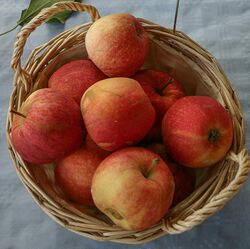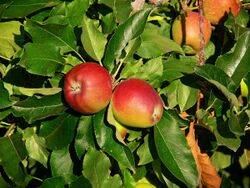Biology:Gala (apple)
| 'Gala' | |
|---|---|
 | |
| Species | Malus domestica |
| Hybrid parentage | 'Kidd's Orange Red' × 'Golden Delicious' |
| Cultivar | Gala |
| Origin | |
Gala is an apple cultivar with a sweet, mild flavour, a crisp but not hard texture, and a striped or mottled orange or reddish appearance. Originating from New Zealand in the 1930s, similar to most named apples, it is clonally propagated. In 2018, it surpassed Red Delicious as the apple cultivar with the highest production in the United States, according to the US Apple Association. It was the first time in over 50 years that any cultivar was produced more than Red Delicious.[2]
Appearance and flavour
Gala apples are non-uniform in colour, usually vertically striped or mottled, with overall orange colour.[1] They are sweet, fine textured, and aromatic,[1] and in addition to being eaten raw and cooked are especially suitable for creating sauces.[3]
- Density 0.86 g/cc
- Sugar 13.5%
- Acidity 4.2 grams/ litre
- Vitamin C 0–5 mg / 100 gram[4]
| 55–60 mm | 60–65 mm | 65–70 mm | 70–75 mm | 75–80 mm | 80–85 mm |
|---|---|---|---|---|---|
| 1% | 6% | 12% | 40% | 38% | 3% |
History
The first Gala apple tree was one of many seedlings resulting from a cross between a Golden Delicious and a Kidd's Orange Red planted in Greytown, Wairarapa, New Zealand in the 1930s by orchardist J.H. Kidd. Selected in 1939, introduced in 1960.[5] Donald W. McKenzie, an employee of Stark Bros Nursery, obtained a US plant patent for the cultivar on October 15, 1974.[6] It is a relatively new introduction to the UK, first planted in commercial volumes during the 1980s. The variety now represents about 20% of the total volume of the commercial production of eating apples grown in the UK, often replacing Cox's Orange Pippin.
Sports (mutations)
Many sports of Gala have been selected, mostly for increased red color, including the popular Royal Gala. The original cultivar produced fruit with orange stripes and a partial orange blush over a yellow background. Since then, several un-patented sports have been recognized. Additionally, more than twenty sports have received US plant patents:
| Date | "Inventor" | Marketed as | Mutated from | Assignee | Habit | Pattern | Earlier | Color | Plant patent number |
|---|---|---|---|---|---|---|---|---|---|
| Feb 20, 2013 | W. Fulford, New Zealand | Regal Gala (Fulford Gala, Gala Must) | Gala | reddish orange blush over a yellow ground | USPP 3309 | ||||
| Oct 15, 1974 | McKenzie | Gala | – | Stark | standard | partial blush | – | yellow | Template:US plant patent |
| Oct 4, 1977 | H.W. Ten Hove, New Zealand | Royal Gala, Tenroy | Gala3637 | Stark | standard | stripe | – | red | Template:US plant patent |
| May 10, 1988 | John Creech, US | Scarlet Gala[7] | Kidd's D-83637 | C & 0 | standard | blush | – | scarlet | Template:US plant patent |
| Aug 1, 1989 | K.W. Kiddle, New Zealand | Galaxy | Tenroy4121 | Stark | standard | stripe | earlier | intense red | Template:US plant patent |
| Dec 18, 1990 | Cooper | Treco Spur Red Gala No. 42, Regal | Auvil | Oregon Rootstock | spur | stripe | – | red | Template:US plant patent |
| Jul 16, 1991 | Fulford | Fulford | Kidd3637 | standard | blush | – | bright red | Template:US plant patent | |
| Mar 1, 1994 | Olsen | Obrogala, UltraRed | Tenroy4121 | Stark | standard | stripe | 2–4 days | redder | Template:US plant patent |
| Apr 5, 1994 | Waliser, US | Waliser Gala | Tenroy4121 | Waliser | standard | stripe | 10 days | bright red | Template:US plant patent |
| May 10, 1994 | Hill | Applewaites | Kidd's3637 | standard | blush | 2–3 days | more complete red | Template:US plant patent | |
| Nov 5, 1996 | Olsen | Olsentwo Gala, Pacific Gala | Royal Gala4121 | standard | stripe | 5–10 days | distinguishably different | Template:US plant patent | |
| Sep 2, 1997 | Paul Brookfield, New Zealand | Baigent | Royal Gala4121 | Brookfield | standard | stripe | extremely early | bright red | Template:US plant patent |
| Nov 11, 1997 | Gale | Gale Gala | Royal Gala4121 | Van Well, US | standard | stripe | 3 weeks | more complete | Template:US plant patent |
| Jun 23, 1998 | Tina Fackler, US | Big Red Gala | Kidd's3637 | Protree | standard | stripe | – | same | Template:US plant patent |
| Mar 30, 1999 | Simmons | Simmons | Imperial | Peace Valley | standard | stripe | 21 days | brighter red | Template:US plant patent |
| Jan 18, 2000 | Stiekema | Stiekema 1 | Obragala8621 | standard | blush | – | red | Template:US plant patent | |
| Apr 11, 2000 | McSpadden, Jr | Caitlin | Tenroy4121 | Stark | standard | stripe | "earlier" | – | Template:US plant patent |
| Aug 13, 2002 | Bob Black, US | Harry Black Gala (Autumn Gala) | Kidd's3637 | International Plant Management | standard | stripe | 5 wk. later | – | Template:US plant patent |
| Apr 29, 2003 | Banning | Banning Gala | Imperial | standard | stripe | – | intense red blush, darker stripe | Template:US plant patent | |
| Jan 6, 2004 | Smith | Smith gala | Tenroy4121 | standard | stripe | – | yellow | Template:US plant patent | |
| May 4, 2004 | Weaver | Weaver | Fulford7589 | Adams County Nursery | more compact | blush | – | bright red | Template:US plant patent |
| Jan 4, 2005 | Ligonniere | Dalitoga | Imperial | SNC Elaris | standard | stripe | 3 wk. | yellow | Template:US plant patent |
| Aug 15, 2006 | Burkitt | Burkitt Gala | Tenroy4121 | BMA Trust | standard | stripe | 10 d. | completely red | Template:US plant patent |
| Feb 26, 2008 | McDonald | El Niño | Royal4121 | standard | intense dark red stripe | bright red | Template:US plant patent | ||
| Jul 8, 2008 | McLaughlin | McLaughlin Gala, Blondee | Kidd's3637 | standard | no striping or blush | 4—6 d. | yellow | Template:US plant patent | |
| Dec 30, 2008 | G. E. Fankhauser, Australia | Alvnia | Gala | Fankhauser | standard | stripes | "earlier" | red, > 95A% coverage | Template:US plant patent |
| Apr 14, 2009 | A. Richard, France | Galaval | Galaxy Gala6955 | Pepinieres du Valois | standard | blush | – | intense dark purple brown | Template:US plant patent |
| Sept 28, 2010 | M. Julien, France | Jugala | Mitchgla Gala | 5 d. | USPP 21315 | ||||
| Aug 14, 2012 | S. Buck, New Zealand | Premier Star | Imperial Gala | USPP 22949 | |||||
| Jul 22, 2014 | R. Wyle, US | Foxtrot | Tenroy Gala | earlier ripening | more intensely red | USPP 24664 | |||
| Apr 7, 2015 | S. Perathoner, Italy | Gala Parathoner | Mitchgla Gala | stripes | light and dark stripes 95–100% | USPP 25407 | |||
| Jan 24, 2017 | A. Gruber-Genetti, Italy | Gala Schnico Red | Gala Schnitzer Scinga | 100% dark red | USPP 27577 | ||||
| May 9, 2017 | A. Defrancesschi, Italy | Gala 2013 | Gala | 100% purple-red | USPP 27978 | ||||
| Jan 23, 2018 | L. Fabre, France | Galafab(Gala Star) | Gala | Red 90–100% | USPP 28885 | ||||
| Dec 25, 2018 | Brisset, France | Gala Surf | Gala | Very dark purple red | USPP 30009 | ||||
| May 21, 2019 | J. Braun, Italy | GalaMic | Gala | Deep purple | USPP 30512 |
Unpatented varieties
| Name | mutated from | year and country |
|---|---|---|
| Auvil | ||
| Imperial Gala | ||
| Ultima Gala (Banning) | Imperial Gala | 1997 US |
Descendant cultivars
| Name | Parentage | Cross made | Introduced | Origin |
|---|---|---|---|---|
| Aurora Golden Gala | Splendour x Gala | 1981 | Canada | |
| Bravo | Cripps Red x Royal Gala | 1992 | Australia | |
| Delfloga | (Royal Gala × Florina) [8] | ? | ? | |
| Envy(Scilate) | (Royal Gala × Braeburn) | 1985 | New Zealand | |
| Gaia | Gala x A3-7 | Italy | ||
| Galarina | Gala x Florina Querina | 1978 | France | |
| Jazz (Scifresh) | Braeburn x Royal Gala | 1985 | ? | New Zealand |
| Nicoter (Kanzi) | (Gala × Braeburn) [9] | Belgium | ||
| Modi | Gala x Liberty | 1992 | Italy | |
| Monalisa | Gala x Malus 4 | Brazil | ||
| Newson | Gala x Hawkes Bay Red Delicious | 1983 | Canada | |
| Nicola | Splendour x Gala | 1981 | Canada | |
| Sciros (Pacific Rose) | (Splendor × Gala)[10] | |||
| Rubens(Civni) | Elstar x Gala | Italy | ||
| Sweetie ('PremA280') | ||||
| Salish | Splendour x Gala | 1981 | 1997 | Canada |
Season
Gala apples are grown from May through September in the northern hemisphere, but, like most apples, are available almost all year through the use of cold storage and controlled atmosphere storage.[11] Australian Gala are available from late January. California fruit is available until October. While the season usually lasts only 9 or 10 months, they are able to last all year round. However, due to some apples continuing to be grown in some orchards, and the fact that they can be refrigerated for some months leads to the availability of the Gala apple year-round in some Australian markets. These usually taste different (slightly less sweet) from those in season. The UK season begins in late summer (August). Storage makes the UK fruit available nearly year-round as with fruit from other origins.
Royal Gala sport
Royal Gala is a Gala sport, patented by Stark in 1977, which produces redder fruits than the original cultivar. It is a pink-red dessert apple and is therefore usually eaten fresh. Royal Galas are usually harvested in early to late February in the southern hemisphere. In New Zealand, the pinker original Gala has almost disappeared as a commercial apple in favor of the darker-skinned Royal Gala.
References
- ↑ 1.0 1.1 1.2 "Gala", National Fruit Collection, http://www.nationalfruitcollection.org.uk/full2.php?id=2183&&fruit=apple, retrieved 31 October 2015
- ↑ 2018 Annual Review U.S. Apple Association.
- ↑ "Royal Gala Apples | Australian Apple Varieties | Aussie Apples". http://www.aussieapples.com.au/aussie-grown-varieties/royal-gala.aspx.
- ↑ 4.0 4.1 Silbereisen, Robert; Götz, Gerhard; Hartmann, Walter; Tambour, Gisela; Eberle, Christl (1996). Obstsorten – Atlas. Ulmer (Eugen). ISBN 9783800155378.
- ↑ Brooks, Olmo. American Society for Horticultural Science, Vol. 91, page 908
- ↑ Template:US plant patent
- ↑ Template:US plant patent
- ↑ "Delfloga". https://www.inspection.gc.ca/english/plaveg/pbrpov/cropreport/app/app00007794e.shtml.
- ↑ United States Patent PP17201
- ↑ Ltd, Orange Pippin. "Apple - Pacific Rose - tasting notes, identification, reviews". https://www.orangepippin.com/apples/pacific-rose.
- ↑ McGlone, V.Andrew; Jordan, Robert B.; Martinsen, Paul J. (2002-06-01). "Vis/NIR estimation at harvest of pre- and post-storage quality indices for 'Royal Gala' apple" (in en). Postharvest Biology and Technology 25 (2): 135–144. doi:10.1016/S0925-5214(01)00180-6. ISSN 0925-5214.
External links
 |





